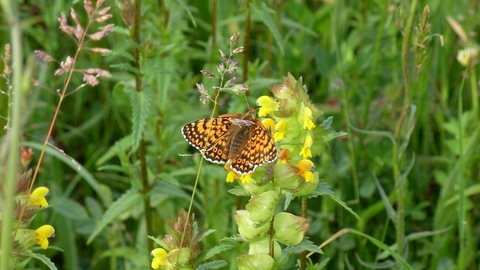
The
Glanville fritillary can be spotted on warm days around coastal
habitats on the Isle of Wight and the Channel Islands, as well as at a
few locations in mainland England.
Species information
Category
- Butterflies
Statistics
Wing span: 41-47mmConservation status
Listed as a Section 41 species of principal importance under the NERC Act in England
UK BAP status: Priority Species
Butterfly Conservation priority: High
European Status: Not threatened
UK BAP status: Priority Species
Butterfly Conservation priority: High
European Status: Not threatened
When to see
May to JuneAbout
The Glanville fritillary is a beautiful orange and brown chequered butterfly that can only be found at a few locations in southern England, as well as on the Channel Islands. It's a sun-loving butterfly, which flies on warm days with little to no wind, and hides away amongst grasses on cooler, windier days.The Glanville fritillary favours habitats where the topsoil is regularly disturbed, allowing its larval foodplant (ribwort plantain) and nectar sources (such as dandelion, hawkweeds, bird's-foot trefoil, and thrift) to flourish. For this reason, it is often encountered on cliff sides, where the regular erosion of the cliffs creates the perfect disturbed conditions. The butterflies often form small discrete colonies, with little contact between them.
How to identify
The Glanville fritillary has a chequered pattern of orange and dark brown on the upper side of its wings. The underside of its hind wings are white with distinct orange bands and black markings.Distribution
The Glanville fritillary is found along the southern coast of the Isle of Wight, in the Channel Islands, and at a few locations in mainland England.It is perhaps more common in Alderney than anywhere else in the British Isles, but it is a vulnerable species, liable to sudden arrivals and disappearances. In Guernsey it is making a comeback, but it has disappeared completely from Jersey in the past decade.
Did you know?
The name "Glanville" is a tribute to Lady Eleanor Glanville, the 17th century naturalist who discovered the species. The butterfly was originally known as the Lincolnshire fritillary, as Lady Glanville first discovered the species in the Lincolnshire Wolds.Eleanor Glanville is sometimes described as the first lady of British natural history; she studied butterflies at a time when it was considered improper behaviour for a respectable woman. After her death, Eleanor Glanville's family disputed her will on the grounds that she had lost her wits, as ‘nobody who was not deprived of their senses would go in pursuit of butterflies'.

ConversionConversion EmoticonEmoticon